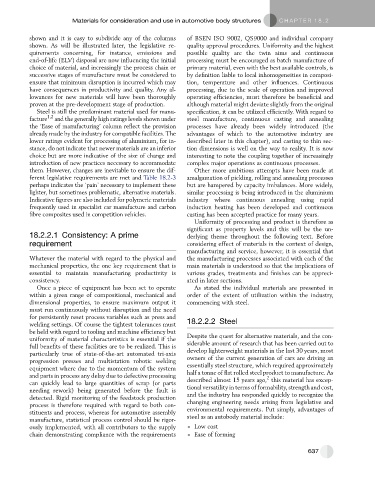Page 629 - Automotive Engineering Powertrain Chassis System and Vehicle Body
P. 629
Materials for consideration and use in automotive body structures C HAPTER 18.2
shown and it is easy to subdivide any of the columns of BSEN ISO 9002, QS9000 and individual company
shown. As will be illustrated later, the legislative re- quality approval procedures. Uniformity and the highest
quirements concerning, for instance, emissions and possible quality are the twin aims and continuous
end-of-life (ELV) disposal are now influencing the initial processing must be encouraged as batch manufacture of
choice of material, and increasingly the process chain or primary material, even with the best available controls, is
successive stages of manufacture must be considered to by definition liable to local inhomogeneities in composi-
ensure that minimum disruption is incurred which may tion, temperature and other influences. Continuous
have consequences in productivity and quality. Any al- processing, due to the scale of operation and improved
lowances for new materials will have been thoroughly operating efficiencies, must therefore be beneficial and
proven at the pre-development stage of production. although material might deviate slightly from the original
Steel is still the predominant material used for manu- specification, it can be utilized efficiently. With regard to
facture 1,2 and the generally high ratings levels shown under steel manufacture, continuous casting and annealing
the ‘Ease of manufacturing’ column reflect the provision processes have already been widely introduced (the
already made by the industry for compatible facilities. The advantages of which to the automotive industry are
lower ratings evident for processing of aluminium, for in- described later in this chapter), and casting to thin sec-
stance, do not indicate that newer materials are an inferior tion dimensions is well on the way to reality. It is now
choice but are more indicative of the size of change and interesting to note the coupling together of increasingly
introduction of new practices necessary to accommodate complex major operations as continuous processes.
them. However, changes are inevitable to ensure the dif- Other more ambitious attempts have been made at
ferent legislative requirements are met and Table 18.2-3 amalgamation of pickling, rolling and annealing processes
perhaps indicates the ‘pain’ necessary to implement these but are hampered by capacity imbalances. More widely,
lighter, but sometimes problematic, alternative materials. similar processing is being introduced in the aluminium
Indicative figures are also included for polymeric materials industry where continuous annealing using rapid
frequently used in specialist car manufacture and carbon induction heating has been developed and continuous
fibre composites used in competition vehicles. casting has been accepted practice for many years.
Uniformity of processing and product is therefore as
significant as property levels and this will be the un-
18.2.2.1 Consistency: A prime derlying theme throughout the following text. Before
requirement considering effect of materials in the context of design,
manufacturing and service, however, it is essential that
Whatever the material with regard to the physical and the manufacturing processes associated with each of the
mechanical properties, the one key requirement that is main materials is understood so that the implications of
essential to maintain manufacturing productivity is various grades, treatments and finishes can be appreci-
consistency. ated in later sections.
Once a piece of equipment has been set to operate As stated the individual materials are presented in
within a given range of compositional, mechanical and order of the extent of utilization within the industry,
dimensional properties, to ensure maximum output it commencing with steel.
must run continuously without disruption and the need
for persistently reset process variables such as press and
welding settings. Of course the tightest tolerances must 18.2.2.2 Steel
be held with regard to tooling and machine efficiency but
uniformity of material characteristics is essential if the Despite the quest for alternative materials, and the con-
full benefits of these facilities are to be realized. This is siderable amount of research that has been carried out to
particularly true of state-of-the-art automated tri-axis develop lighterweight materials in the last 30 years, most
owners of the current generation of cars are driving an
progression presses and multistation robotic welding
essentially steel structure, which required approximately
equipment where due to the momentum of the system
half a tonne of flat rolled steel product to manufacture. As
and parts in process any delay due to defective processing 2
described almost 15 years ago, this material has excep-
can quickly lead to large quantities of scrap (or parts
tional versatility in terms of formability, strength and cost,
needing rework) being generated before the fault is
and the industry has responded quickly to recognize the
detected. Rigid monitoring of the feedstock production
process is therefore required with regard to both con- changing engineering needs arising from legislative and
stituents and process, whereas for automotive assembly environmental requirements. Put simply, advantages of
manufacture, statistical process control should be rigor- steel as an autobody material include:
ously implemented, with all contributors to the supply Low cost
chain demonstrating compliance with the requirements Ease of forming
637

